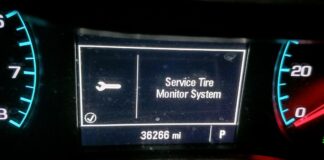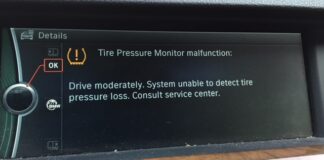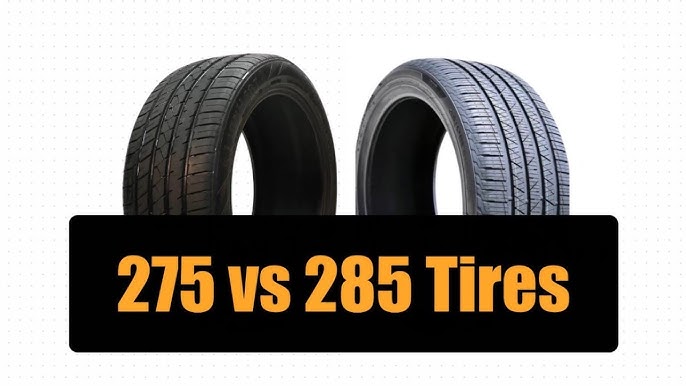The primary distinction between 275 and 285 tires lies in their width. These numbers represent the tire’s width in millimeters. The choice of tires for a vehicle hinges on factors like vehicle type, terrain, manufacturing year, and the manufacturer’s guidelines. Using tires that are excessively wide can pose safety risks.
What Are the Key Differences Between 275 and 285 Tires?
The main difference between tires labeled 275 and 285 is their width. These numbers indicate the tire’s width in millimeters, not the tire’s overall circumference. Tire width is always measured in millimeters, not inches or centimeters.
Clearly, the difference between a 275mm and a 285mm tire is 10mm. However, those 10mm are significant.
How to Identify Tire Width?
If a vehicle owner is unsure about the appropriate tire width for their car, a mechanic can assist. By checking the vehicle’s make and model, a mechanic can determine the manufacturer’s recommended tire sizes.
Alternatively, vehicle owners can contact the car manufacturer directly to inquire about tire width recommendations. Most manufacturers provide a customer service phone number or email for such queries.
When reaching out to the manufacturer, owners should have their vehicle’s VIN, make, model, and year ready. This information helps customer service representatives provide accurate guidance.
If the vehicle includes an owner’s manual, the recommended tire width sizes are typically listed within it.
Checking the Tire Sidewall for Width
The simplest way to find out a vehicle’s tire size is to inspect the tire currently mounted on the wheel hub and read its markings.
Every tire has a series of numbers and letters on its sidewall, indicating its specifications. These markings are visible without needing to crouch down to the tire’s level.
● The first letter shows whether the tire is designed for passenger vehicles, light trucks, special trailers, or temporary use.
● The following three digits represent the tire’s width in millimeters. A higher number means a wider tire.
● After the “/” symbol, the numbers indicate the aspect ratio, followed by a letter such as R, X, B, or -.
● The next two digits show the bead diameter in inches.
● The final three symbols provide the service description.
By simply reading the sidewall, you can identify the tire’s width and other characteristics. Try checking your vehicle’s tire sidewall next time you’re nearby—it’s straightforward.
How to Know If Your Vehicle Needs 275 or 285 Tires?
As noted earlier, the acceptable range of tire widths for a vehicle is usually found in the owner’s manual.
You can also research the vehicle’s make and model to find tire width recommendations.
Additionally, knowing the vehicle’s weight can help determine whether a narrower or wider tire is needed.
What Happens If I Use 285 Tires on a Vehicle Needing Smaller Ones?
Mechanics strongly discourage using tires that are either too small or too large for a vehicle. Incorrect tire sizes can lead to serious issues.
Issues with Overly Wide Tires
A tire that’s too wide may come into contact with the vehicle’s suspension components. While occasional contact with the fender liner is acceptable, contact with suspension parts is not.
An overly wide tire can cause permanent damage to the suspension, affect electrical wiring, and harm the tire itself.
Issues with Undersized Tires
Smaller tires can support less weight. If a vehicle requires wider tires, it’s likely because it’s heavier.
Using a tire that’s too narrow can lead to steering problems, as it may not provide enough traction for proper control.
For vehicles with two-wheel steering, a tire that’s too small can reduce speed and turning ability, especially in wet or icy conditions.
Issues with Oversized Tires
A tire that’s too wide can increase the bumper’s height from the ground. This may cause misalignment in the wheel hub and steering system.
A vehicle with an incorrectly sized tire is more likely to roll over if struck from any side.
Using an incorrectly sized tire is only advisable in emergencies. When doing so, avoid high speeds and stay out of the fast lane on highways.
Once the emergency is resolved, the tire must be replaced with one that matches the vehicle’s specifications.
Failing to replace an incorrectly sized tire can compromise the vehicle’s stability and the driver’s safety.
Final Thoughts
The first three digits on a tire’s sidewall indicate its width in millimeters. Tires come in various widths, but not every tire is suitable for every vehicle. Wider tires are designed for heavier vehicles, while narrower ones suit lighter ones.
Installing a tire that’s too wide or too narrow for a vehicle is risky. A tire that’s too wide increases the chance of a rollover during an accident.








